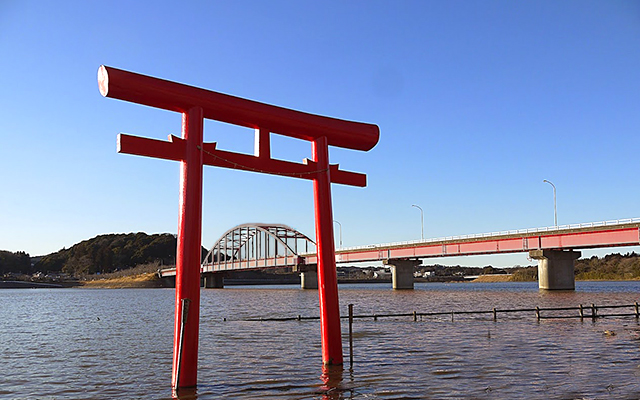
(C) Grape Japan
A Memorable Excursion to Idyllic Takataki Lake – Part 2: Scenic Walk, Museum and Shrine
- Source:
- (C) Ichihara Lakeside Museum / (C) Ichihara Zo no Kuni Co., Ltd. / (C) Beat International Co., Ltd.
- Tags:
- bait / bass / boat rental / Boso Peninsula / Bridge / Chibanian / contemporary art / dam / dragonfly / elephant rides / elephant shows / elephants / fishing / fishing boat / free shuttle / geology / Gift Shop / Haiku / Ichihara City / Ichihara Elephant Kingdom / Ichihara Lakeside Museum / Japanese poetry / Kamo Bridge / kingfisher / Kominato Line / Kominato Railways / Manyoshu / Masaoka Shiki / memorial / modern art / observatory / paddle boat / pier / Pizza / pizzeria / Pizzeria Bosso / poems / quay / red bridge / Restaurant / Sarashina Diary / Sarashina Nikki / Sculpture / smelt / Takataki / Takataki Lake / Takataki Shrine / Takataki Station / torii / Torii gate / Tsukizaki Station / wakasagi / wakasagi smelt / water wheel / Yosa no Buson / Zo no Kuni / Zoo
Related Article
-

Japan opens its first non-alcoholic bar with full vegan menu
-

Domino’s Japan serves up the definitive taste of Japan with 4-flavor Nippon pizza
-

Artist crafts amazing ancient Japanese pottery…out of tofu packaging
-

American can’t stop laughing at Japanese wife’s pizza topping ideas [manga]
-

Where BTS Visited in Tokyo: Must Visit Restaurants and Attractions for ARMY
-

All-You-Can-Eat Fall Buffet Is Filled With Fragrant Matsutake Mushroom Dishes and Colorful Regional Vegetables


Continuing from last week, when we reviewed the quaint and scenic Kominato Line which purrs along with its diesel engine and diminutive two-carriage length on its path through mostly unmanned stations dotting the countryside of Boso Peninsula, this week, we've finally arrived at our destination, Takataki Lake.
Here's where we left off, at Takataki Station:
Source: Grape Japan
Once you exit Takataki Station and walk a few yards straight ahead, turn left onto the main road. Then, take your first left as indicated below:
Source: Grape Japan
Go through the railroad crossing and begin walking up the hill on the left side of the road. Just before entering the forested area, you'll have a good view of Takataki Station in the distance. Keep walking for another five minutes.
Source: Grape Japan
As you head down the other side of the hill, you'll see Takataki Lake in the distance. One the left, you'll see the back entrance of Takataki Shrine. We'll take a better look later.
Source: Grape Japan
At this spot, you'll have a superb view of the Lake on both sides of the red Kamo Bridge that divides the area.
Source: Grape Japan
Take in the natural beauty of the area before walking across the bridge.
Source: Grape Japan
Crossing Kamo Bridge will take you another five to ten minutes. If you visit in winter, be sure to dress warmly as gusts of wind can be quite strong on the bridge.
Source: Grape Japan
You may notice several sculptures in the lake, representing birds and insects such as Kagerou (dragonfly) and Kawasemi (kingfisher).
Source: Grape Japan
Source: Grape Japan
When you reach the other side of the bridge, turn right after the Suzuki car shop. On the right side, you'll see Takataki Lake Park. There is a facility here which rents boats for fishing. You can also fish from one of several quays which are covered for protection in bad weather. The lake is most famous for wakasagi smelt but you can also fish for bass. The center also sells bait.
Source: Grape Japan
Source: Grape Japan
Source: Grape Japan
There is a Shinto torii gate standing near the edge of the water facing in the direction of Takataki Shrine. Once a year, during the Takataki Shrine Fall Festival, the portable mikoshi is carried from the main shrine, across the bridge and to this torii gate, then back again.
Source: Grape Japan
Source: Grape Japan
If you continue walking up the main road, and across a smaller bridge, you'll soon see a modern-looking building which almost seems out of place in the rural surroundings of the Takataki area. This is the Ichihara Lakeside Museum, a museum of contemporary art that has earned a reputation for hosting artists from all over Japan and even from abroad. Opening hours are 10 am to 5 pm on weekdays and 9:30 am to 7 pm on Saturdays and days before national holidays, and 9:30 am to 6 pm on Sundays and holidays.
Source: Grape Japan
The entrance is a bit hard to find, but it's just around the corner.
Source: Grape Japan
If you look closely at the wall, you'll notice that these metallic strips are engraved with Japanese text. An installation by Yoshiaki Irobe, who also designed the signage and logos in the museum, these are in fact lines of classical Japanese poetry from Sarashina Diary, Manyoshu, and haiku masters Yosa no Buson and Masaoka Shiki pertaining to the plants and flowers native to the Ichihara area.
Source: Grape Japan
The lawn area contains several works of art such as Katsuyuki Shinohara's "Hirai".
Source: Grape Japan
You may also notice what looks like a black observation tower above a water wheel. This is a work by Shigemura Mitsuo commemorating the water wheels used in this area to irrigate rice fields before the Takataki Dam was built. If you climb to the top, you'll be rewarded with a great view of the whole area.
Source: Grape Japan
If you've worked up an appetite after all that walking and going up and down the stairs of the observatory, the perfect place for lunch is Pizzeria Bosso, a wonderful slice of Italy smack in the middle of the Japanese countryside serving delicious pizzas baked in authentic wood oven, with locally-sourced Chiba Prefecture ingredients. Please watch for our separate review in the next few days.
Source: Grape Japan
We made our way back across the red bridge and headed towards Takataki Shrine.
Source: Grape Japan
Since it was the New Year period, the shrine was very busy with members of the local community visiting to say prayers for the year to come.
Source: Grape Japan
Source: Grape Japan
Source: Grape Japan
The shrine is nested in a densely forested hill which has been designated a Natural Monument by Chiba Prefecture. Before leaving, take a good look at the lake from the vantage point of the steps.
Source: Grape Japan
If you came early and have more time in your day, you can also visit the excellent Zo no Kuni (Ichihara Elephant Kingdom) with elephant shows, elephant rides, elephant painting demonstrations, a mini zoo with prairie dogs, beavers, llamas, alpacas, camels, hippos, capybaras and Patagonian maras, not to mention restaurants and gift shops. A free shuttle leaves daily from Takataki Station at 2:30pm on weekdays and 1:15pm on weekends and holidays. Other shuttles are also available for those arriving by highway bus. More details are available here.
Another alternative addition to your excursion in the Boso Peninsula, and a must-see spot for science (and particularly geology) fans is "the Chibanian site." An outcrop along the Yoro River, the site illustrates the boundary between the Early and Middle Pleistocene (770,000 years ago), when the last geomagnetic field reversal occurred. Once it is officially approved, a virtually foregone conclusion, not only will the site become Japan's first Global Boundary Stratotype Section and Point (GSSP), but “Chibanian” will be used henceforth around the world to designate the geological age from 770,000 to 126,000 years ago. To visit, simply get off at Tsukizaki Station on your way back to Goi from Takataki. A free shuttle leaves from Tsukisaki Station at 1:30 pm、1:55 pm and 2:22 pm and leaving from the site at 2:07 pm、2:34 pm、3:12 pm and 3:30 pm. The shuttle only runs on weekends, so you'll need to walk about a half hour from the station if you're visiting on a weekday.